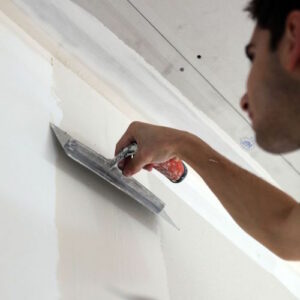
The disturbing trend is that some of these contractors believe it is perfectly acceptable to skim the wall out with joint compound. It is often found that there is a veneer plaster under a thin coat of soft joint compound. This would lead designers and building owners to question if they got a specified veneer plaster system. A multitude of nicks, gouges, scrapes and scratches leave owners upset with the veneer plaster as a system. The NWCB has done many site investigations over the last few years, where building owners have complained that the veneer plaster simply does not live up to the abuse resistance that is claimed. The practice of skimming the hard veneer with a soft joint compound defeats the primary intent of the veneer plaster in the first place: abuse resistance. More often than not, a lightweight joint compound was used for easy sanding. To make the job "sellable," they often resort to skimming the entire surface with joint compound and sanding the surface to a smooth finish.
VENEER PLASTER CORNER TRIM FREE
This would lead to having trouble achieving a smooth finish, free of trowel marks, voids, catfaces and other imperfections. Some have resorted to semi-skilled tradesmen to keep up with schedules. Unfortunately, many wall and ceiling contractors and tradespeople may have overstated their abilities to provide a smooth veneer plaster system. There is a combination of items that created a perfect storm that has occurred in the world of interior plaster, namely, the creation of lightweight joint compounds and an increase loss of skilled interior plasterers. Since perfection is not obtainable, plasterers would often have to go back and touch-up minor imperfections after the plaster set and dried. The fat is then used to fill small blemishes and voids, sometimes called "catfaces." This process is the key to a good, smooth trowel finish veneer plaster system. The idea behind hard water troweling is to bring the "fat" out of the plaster while compacting the surface. (The true two-coat system with an aggregate basecoat is more abuse resistant and allows the plaster crew some additional time to work the material.) A one-coat system is the finish coat applied in two passes. Two-coat systems use a veneer plaster basecoat that has some aggregate in the plaster. Veneer plaster can be one- or two-coat systems.

When properly installed, they will get a system that is hard to beat when you consider the service life of a building. In both systems, architects specify veneer plaster to provide their clients a lower maintenance to the walls.
VENEER PLASTER CORNER TRIM UPGRADE
Most designers think of this type of veneer plaster as an upgrade to a conventional gypsum board system. The residential type of veneer plaster is a little easier to trowel to a smooth finish and still provides a finish surface much harder than traditional gypsum board finish.

The institutional type is very hard, dense and provides a finished surface that has proven to stand up to the everyday abuses common in buildings such as police stations, schools and hospitals. The NWCB refers to them often as the residential type and then the institutional/commercial type. There are two basic types of veneer plaster systems.


 0 kommentar(er)
0 kommentar(er)
